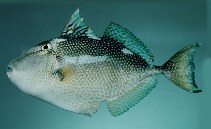| Family: |
Balistidae (Triggerfishes) |
| Max. size: |
60 cm TL (male/unsexed) |
| Environment: |
demersal; marine; depth range 7 - 350 m, amphidromous |
| Distribution: |
Indo-West Pacific: Red Sea, East Africa eastward through northern Australia to Fiji, northward to southern Japan. |
| Diagnosis: |
Dorsal spines (total): 3-3; Dorsal soft rays (total): 25-27; Anal spines: 0-0; Anal soft rays: 24-26. Scales enlarged above the pectoral fin base and just behind the gill slit to form a flexible tympanum; scales of posterior body with prominent keels, forming longitudinal ridges. A prominent groove in the skin extending anteriorly from front of eye for a distance of about 1 eye diameter. Caudal peduncle depressed. Caudal fin rays of adults prolonged above and below. |
| Biology: |
Inhabit coastal areas, usually found over muddy and sandy bottoms, also around reefs, together with the sponges and algae (Ref. 5213). Adults on deep coastal slopes and usually seen swimming high above the bottom, sometimes found in estuaries. Juveniles in sheltered coastal bays and estuaries with outcrops of rubble or debris on open substrates (Ref. 48637). Feed on benthic animals (Ref. 9769). Oviparous (Ref. 205). Also caught with vertical long-lines (Ref. 9770). Marketed fresh and dried-salted (Ref. 9770). |
| IUCN Red List Status: |
Least Concern (LC); Date assessed: 11 January 2022 Ref. (130435)
|
| Threat to humans: |
harmless |
Source and more info: www.fishbase.org. For personal, classroom, and other internal use only. Not for publication.
